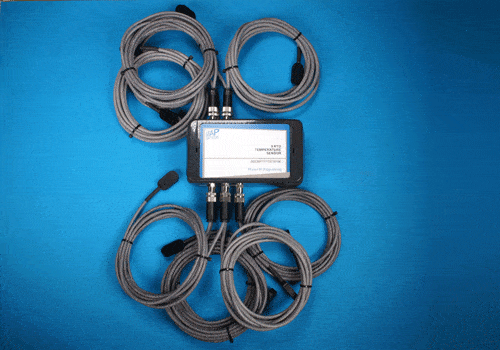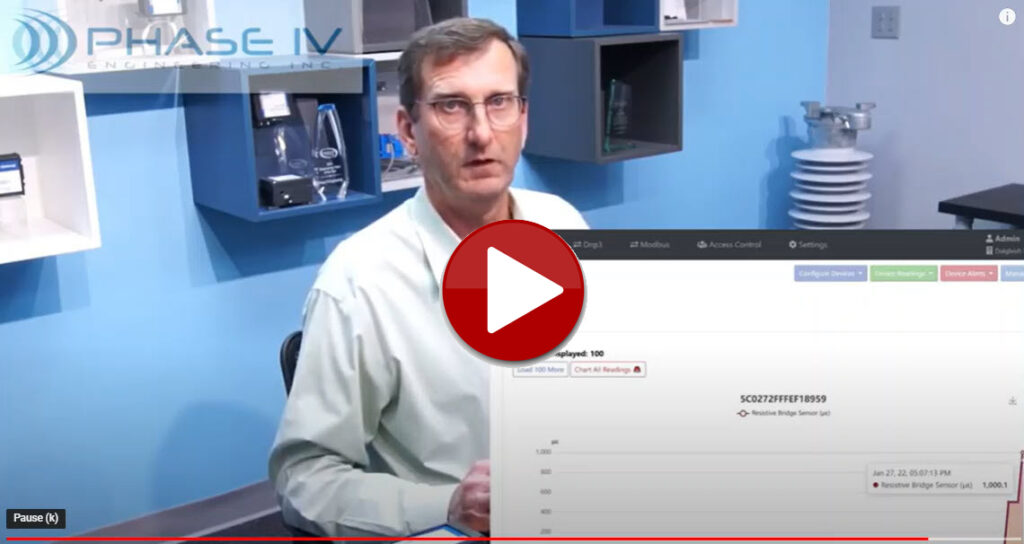-
 The Leap wireless pressure transceiver can integrate with every type of sensor with a 0 - 5 V output. The sensor is powered by the Leap Sensor device battery with a power supply that can be specified from 0 to 24 volts. No external power source is needed. Contact us to let us help you make your selected 0 - 5 V sensor wireless. Part of the breakthrough Leap Sensors® system. Build your quote here:
The Leap wireless pressure transceiver can integrate with every type of sensor with a 0 - 5 V output. The sensor is powered by the Leap Sensor device battery with a power supply that can be specified from 0 to 24 volts. No external power source is needed. Contact us to let us help you make your selected 0 - 5 V sensor wireless. Part of the breakthrough Leap Sensors® system. Build your quote here: -
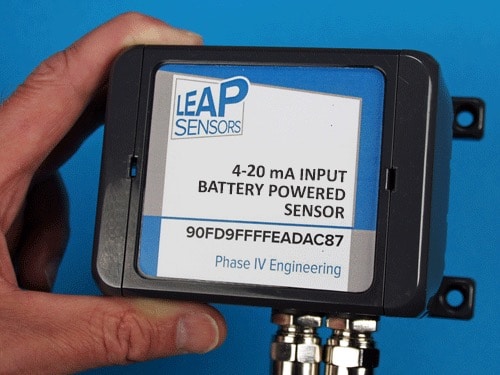 The Leap wireless 4-20 mA transceiver node can integrate with every type of sensor with a 4-20mA output.
The Leap wireless 4-20 mA transceiver node can integrate with every type of sensor with a 4-20mA output.Configured to Your Exact Application
The external industrial sensor may be powered by an optional 12 or 24V power supply driven from the over-sized Leap Sensor node battery. No external power source is needed with the 12/24V power supply option (LP-1PXX). See below for other options to configure this industrial wireless sensor node to your exact needs. Contact us to let us help you make your selected 4-20 mA sensor wireless. Part of the breakthrough Leap Sensors® system. Build your quote here: -
 This Leap Sensor comes with a fast-to-install split-core AC amp clamp to sense the AC electrical current going to equipment. Amp clamps are a powerful industrial tool to monitor power usage and to monitor equipment for conditions that predict impending failures. A change in AC current to industrial equipment can be an early indication to plan downtime to prevent failures during production. A wide range of amp clamps can be integrated with the Leap system. Contact us with your specific needs.Price for 0-50A AC RMS current transformer. Contact us for pricing on other current transformer options.Contact Us
This Leap Sensor comes with a fast-to-install split-core AC amp clamp to sense the AC electrical current going to equipment. Amp clamps are a powerful industrial tool to monitor power usage and to monitor equipment for conditions that predict impending failures. A change in AC current to industrial equipment can be an early indication to plan downtime to prevent failures during production. A wide range of amp clamps can be integrated with the Leap system. Contact us with your specific needs.Price for 0-50A AC RMS current transformer. Contact us for pricing on other current transformer options.Contact UsPrices, Quotes, Questions...
Need a price or a quote? Have questions? Want to talk to an expert? Need a custom solution?Contact Us -
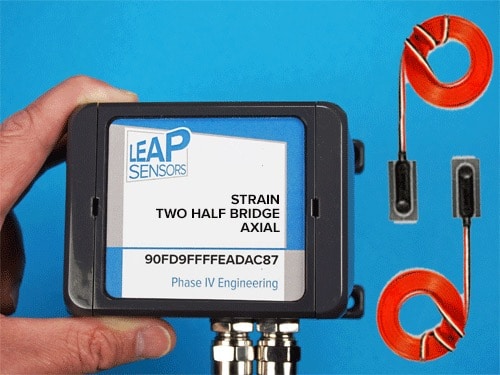 Integrate almost any strain sensor into a Leap Sensors wireless transceiver node for structural health monitoring (SHM) on bridges, overpasses, support beams, and more. Easy to install on existing structures. Be up & running in just a few minutes.
Integrate almost any strain sensor into a Leap Sensors wireless transceiver node for structural health monitoring (SHM) on bridges, overpasses, support beams, and more. Easy to install on existing structures. Be up & running in just a few minutes.Wireless Strain Demonstration and Tutorial
Contact us to find the best strain sensor configuration for your specific application. Part of the breakthrough Leap Sensors® system. Strain sensors are not included. Contact us and one of our experts can recommend strain gauges for your application. We offer easy-to-install spot-weld-on strain sensors. We also have a Micro Measurements battery-powered spot welder available for rent. Build your quote here: -
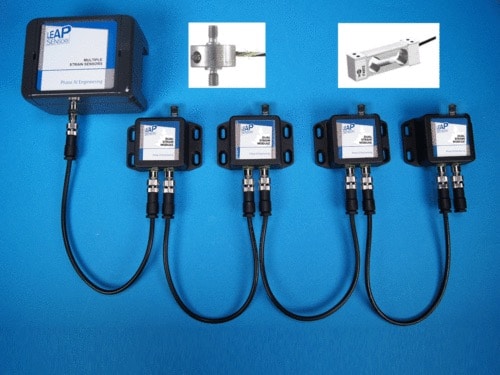 Breakthrough technology uses CAN bus to "daisy chain" multiple load cell interface modules to one wireless Leap transceiver node. Anywhere from 2 to 30 load cell modules can be added to the bus. Each load cell module can support 2 full-bridge mV/V load cells, for a total of up to 60 load cells per transceiver node. Edge processing at the strain sensor level assures a high-quality conversion of the sensor voltage reading to a digital reading, which can then be reliably sent via the CAN bus to the wireless transceiver node. Industrial CAN bus cables can be over 600 feet long. Ideal for wireless monitoring loads and force in several places along structural components such as I-beams, girders, support columns, etc. Contact us to find the best strain sensor configuration for your specific application. Part of the breakthrough Leap Sensors® system. Contact us for pricing on your specific configuration. Build your quote here:
Breakthrough technology uses CAN bus to "daisy chain" multiple load cell interface modules to one wireless Leap transceiver node. Anywhere from 2 to 30 load cell modules can be added to the bus. Each load cell module can support 2 full-bridge mV/V load cells, for a total of up to 60 load cells per transceiver node. Edge processing at the strain sensor level assures a high-quality conversion of the sensor voltage reading to a digital reading, which can then be reliably sent via the CAN bus to the wireless transceiver node. Industrial CAN bus cables can be over 600 feet long. Ideal for wireless monitoring loads and force in several places along structural components such as I-beams, girders, support columns, etc. Contact us to find the best strain sensor configuration for your specific application. Part of the breakthrough Leap Sensors® system. Contact us for pricing on your specific configuration. Build your quote here: -
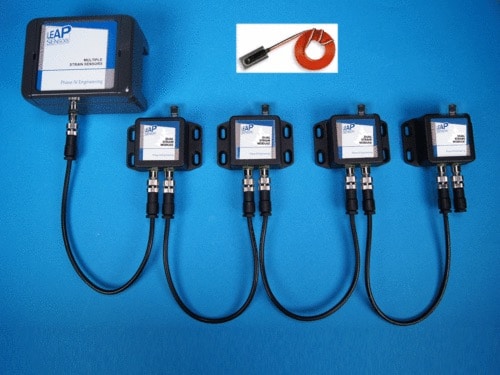 Breakthrough technology uses CAN bus to "daisy chain" multiple small strain gauge sensor modules to one wireless Leap transceiver node. Anywhere from 1 to 16 strain gauge modules can be added to the bus. Each CAN strain module can support 2 full-bridge resistive strain gauge sensors, for a total of up to 32 full-bridge strain gauges per transceiver node. Edge processing at the strain sensor level assures a high-quality conversion of the sensor voltage reading to a digital reading, which can then be reliably sent via the CAN bus to the wireless transceiver node. Industrial CAN bus cables can be over 600 feet long. Ideal for wireless monitoring of strain in multiple points along structural components such as I-beams, girders, hanging structures, support columns, railways etc., as well as industrial applications such as rotating shafts in engines, turbines, etc.
Breakthrough technology uses CAN bus to "daisy chain" multiple small strain gauge sensor modules to one wireless Leap transceiver node. Anywhere from 1 to 16 strain gauge modules can be added to the bus. Each CAN strain module can support 2 full-bridge resistive strain gauge sensors, for a total of up to 32 full-bridge strain gauges per transceiver node. Edge processing at the strain sensor level assures a high-quality conversion of the sensor voltage reading to a digital reading, which can then be reliably sent via the CAN bus to the wireless transceiver node. Industrial CAN bus cables can be over 600 feet long. Ideal for wireless monitoring of strain in multiple points along structural components such as I-beams, girders, hanging structures, support columns, railways etc., as well as industrial applications such as rotating shafts in engines, turbines, etc.Wireless Strain Demonstration and Tutorial
Contact us to find the best strain sensor configuration for your specific application. Part of the breakthrough Leap Sensors® system. Multiple strain sensing modules attach to the transceiver node over a CAN bus. Each module can support two full-bridge strain sensors. The strain modules are ordered separately. Contact Us and an Application Engineer will work with you to provide a detailed final quote that meets your specific application. Build your quote here: -
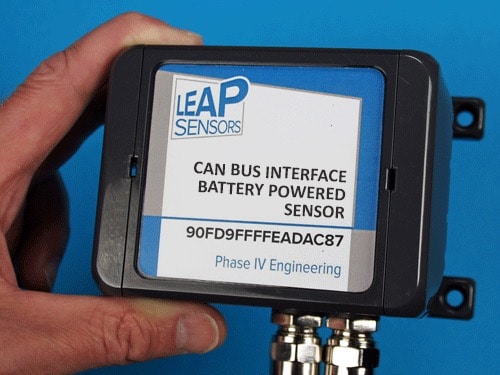 The Leap wireless transceiver can integrate with most sensors with a CAN bus interface. The sensor is powered by the Leap Sensor device battery with a power supply that can be specified from 3.6V to 24 volts. No external power source is needed. Contact us to let us help you make your selected CAN bus sensor wireless. Part of the breakthrough Leap Sensors® system. Contact us with the details of the CAN sensor that you want to integrate with the Leap wireless sensor system. Build your quote here:
The Leap wireless transceiver can integrate with most sensors with a CAN bus interface. The sensor is powered by the Leap Sensor device battery with a power supply that can be specified from 3.6V to 24 volts. No external power source is needed. Contact us to let us help you make your selected CAN bus sensor wireless. Part of the breakthrough Leap Sensors® system. Contact us with the details of the CAN sensor that you want to integrate with the Leap wireless sensor system. Build your quote here: -
 Get instantaneous flow rate information without cutting into pipes and running signal wires. The Leap Sensors wireless transceiver node can integrate with a wide range of ultrasonic and Doppler clamp-on flow meters. Connect to plant software with the Modbus interface or use Leap's cloud-based software. Due to the large power consumption of ultrasonic and Doppler flow meters, the flow meter must be powered by 120V. Data from the flow meter is sent wirelessly via a gateway to the software. Clamp-on flow meters are available for a wide range of pipe sizes from 0.5 to 48 inches. Use for metal or plastic pipes. Contact us to find the best clamp-on flow sensor for your application. Part of the breakthrough Leap Sensors® system. Build your quote here:
Get instantaneous flow rate information without cutting into pipes and running signal wires. The Leap Sensors wireless transceiver node can integrate with a wide range of ultrasonic and Doppler clamp-on flow meters. Connect to plant software with the Modbus interface or use Leap's cloud-based software. Due to the large power consumption of ultrasonic and Doppler flow meters, the flow meter must be powered by 120V. Data from the flow meter is sent wirelessly via a gateway to the software. Clamp-on flow meters are available for a wide range of pipe sizes from 0.5 to 48 inches. Use for metal or plastic pipes. Contact us to find the best clamp-on flow sensor for your application. Part of the breakthrough Leap Sensors® system. Build your quote here: -
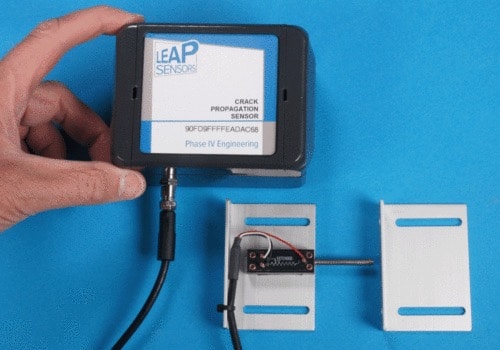 The Leap wireless sensors can integrate with all types linear sensors and crack propagation sensor. Contact us to find the best load cell configuration for your specific application. Part of the breakthrough Leap Sensors® system. Build your quote here:
The Leap wireless sensors can integrate with all types linear sensors and crack propagation sensor. Contact us to find the best load cell configuration for your specific application. Part of the breakthrough Leap Sensors® system. Build your quote here: -
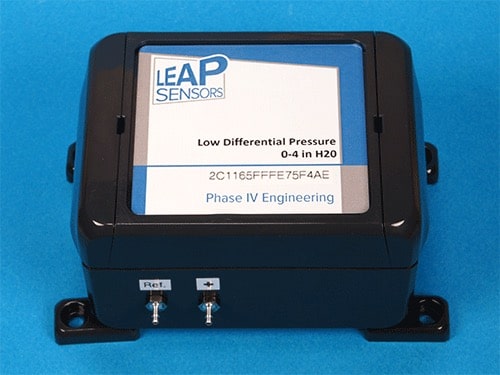 This very unique wireless sensor works by comparing the readings from one device node to another user-selected device node - then reporting the local pressure, local temperature - then differential pressure and temperature as compared to a user selected sensor. For example, sensor A is located outside at ambient temperature and pressure. Sensor B is located in a clean room under positive pressure and Sensor C is located in a different part of the cleanroom under a higher positive pressure. Sensor B could be configured to report its pressure and temperature and the differential pressure between Sensor B and Sensor A. (See the screen shot). Sensor C could be configured to report its pressure and temperature and the differential pressure and temperature between sensor C and sensor B. Sensor readings are reported in PSIA. Leverage the Leap SensorManager software to send text, email, or telephone alerts when a pressure, temperature, or delta-pressure or delta-temperature threshold is exceeded. Integrate the data from the differential pressure sensors into other software using our web-based API, Modbus, DNP3, or other data interface protocols. The wireless sensor can be configured with pressure sensors that have different ranges, resolutions, and accuracies for different applications. See the specification below for more information on the different options. Pressure sensors can be configured to specific applications. The pressure and temperature sensors in the photos have the pressure and temperature sensor sealed inside the enclosure with a pressure port in the back of the enclosure. Part of the breakthrough Leap Sensors® system. Build your quote here:
This very unique wireless sensor works by comparing the readings from one device node to another user-selected device node - then reporting the local pressure, local temperature - then differential pressure and temperature as compared to a user selected sensor. For example, sensor A is located outside at ambient temperature and pressure. Sensor B is located in a clean room under positive pressure and Sensor C is located in a different part of the cleanroom under a higher positive pressure. Sensor B could be configured to report its pressure and temperature and the differential pressure between Sensor B and Sensor A. (See the screen shot). Sensor C could be configured to report its pressure and temperature and the differential pressure and temperature between sensor C and sensor B. Sensor readings are reported in PSIA. Leverage the Leap SensorManager software to send text, email, or telephone alerts when a pressure, temperature, or delta-pressure or delta-temperature threshold is exceeded. Integrate the data from the differential pressure sensors into other software using our web-based API, Modbus, DNP3, or other data interface protocols. The wireless sensor can be configured with pressure sensors that have different ranges, resolutions, and accuracies for different applications. See the specification below for more information on the different options. Pressure sensors can be configured to specific applications. The pressure and temperature sensors in the photos have the pressure and temperature sensor sealed inside the enclosure with a pressure port in the back of the enclosure. Part of the breakthrough Leap Sensors® system. Build your quote here: -
 Wireless differential pressure gauge monitors at low pressure levels. This powerful sensor can be used alongside or as a replacement for magnehelic gauges when continuous remote equipment monitoring and alerts are needed. Ideal for monitoring HVAC filters, exhaust blowers, and differential pressure across clean rooms. Standard pressure ranges are: 0.15 PSID (-1P01) and 1.0 PSID (-1P07). Contact us for 0.3 PSID (-1P06, longer lead time). Build your quote here:
Wireless differential pressure gauge monitors at low pressure levels. This powerful sensor can be used alongside or as a replacement for magnehelic gauges when continuous remote equipment monitoring and alerts are needed. Ideal for monitoring HVAC filters, exhaust blowers, and differential pressure across clean rooms. Standard pressure ranges are: 0.15 PSID (-1P01) and 1.0 PSID (-1P07). Contact us for 0.3 PSID (-1P06, longer lead time). Build your quote here:
